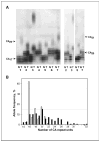Down-regulation of epidermal growth factor receptor by selective expansion of a 5'-end regulatory dinucleotide repeat in colon cancer with microsatellite instability
- PMID: 19584170
- PMCID: PMC2885604
- DOI: 10.1158/1078-0432.CCR-08-1282
Down-regulation of epidermal growth factor receptor by selective expansion of a 5'-end regulatory dinucleotide repeat in colon cancer with microsatellite instability
Abstract
Purpose: The epidermal growth factor receptor (EGFR) is overexpressed in several tumor types, and its expression is influenced by the length of a 5'-end microsatellite repeat (CA)n: the longer the repeat, the lower the expression. Dinucleotide repeats accumulate insertion/deletion types of mutations in tumors with microsatellite instability. We designed this study to estimate the occurrence of these mutations in EGFR(CA)n and their relevance in carcinogenesis of microsatellite instability-positive colon and gastric tumors.
Experimental design: We analyzed the frequency of EGFR(CA)n mutations in vivo in 55 colorectal and 14 gastric microsatellite instability-positive cancers, and in vitro in single-cell clone cultures of microsatellite instability-positive colon tumor cell line LS174. Single-cell clone cultures with different repeat lengths were analyzed by fluorescent-activated cell sorter for EGFR cell-surface expression. A correlation analysis was done between EGFR(CA)n mutations and mutations in KRAS, BRAF, and p53.
Results: Unlike single-cell clone cultures, which exhibited higher rate of deletions compared with insertions, most of EGFR(CA)n mutations in colon and gastric tumors were insertions. Longer EGFR(CA)n correlated with lower EGFR cell-surface expression in single-cell clone cultures. In colon cancers, the elongation of the repeat was associated negatively with mutations in KRAS and BRAF, but not in p53.
Conclusions: The EGFR(CA)n elongation observed in tumors cannot be explained by an intrinsic property of this repeat favoring insertions versus deletions. Instead, a selection for repeat elongation occurs in microsatellite instability-positive tumors, leading to EGFR down-regulation. These findings suggest that in microsatellite instability-positive tumors current therapies targeting EGFR overexpression may have either no effect or an opposite to the expected effect.
Conflict of interest statement
No potential conflicts of interest were disclosed.
Figures



Similar articles
-
An A13 repeat within the 3'-untranslated region of epidermal growth factor receptor (EGFR) is frequently mutated in microsatellite instability colon cancers and is associated with increased EGFR expression.Cancer Res. 2009 Oct 1;69(19):7811-8. doi: 10.1158/0008-5472.CAN-09-0986. Epub 2009 Sep 29. Cancer Res. 2009. PMID: 19789347 Free PMC article.
-
Somatic deletions of the polyA tract in the 3' untranslated region of epidermal growth factor receptor are common in microsatellite instability-high endometrial and colorectal carcinomas.Arch Pathol Lab Med. 2012 May;136(5):510-6. doi: 10.5858/arpa.2010-0638-OA. Arch Pathol Lab Med. 2012. PMID: 22540299 Free PMC article.
-
Inverse relationship between microsatellite instability and K-ras and p53 gene alterations in colon cancer.Am J Pathol. 2001 Apr;158(4):1517-24. doi: 10.1016/S0002-9440(10)64102-8. Am J Pathol. 2001. PMID: 11290569 Free PMC article.
-
KRAS, NRAS, BRAF, HER2 and microsatellite instability in metastatic colorectal cancer - practical implications for the clinician.Radiol Oncol. 2019 Sep 24;53(3):265-274. doi: 10.2478/raon-2019-0033. Radiol Oncol. 2019. PMID: 31553708 Free PMC article. Review.
-
Prognostic and predictive biomarkers for anti-EGFR monoclonal antibody therapy in RAS wild-type metastatic colorectal cancer: a systematic review and meta-analysis.BMC Cancer. 2023 Nov 16;23(1):1117. doi: 10.1186/s12885-023-11600-z. BMC Cancer. 2023. PMID: 37974093 Free PMC article.
Cited by
-
Emerging roles of macrosatellite repeats in genome organization and disease development.Epigenetics. 2017 Jul 3;12(7):515-526. doi: 10.1080/15592294.2017.1318235. Epub 2017 Apr 20. Epigenetics. 2017. PMID: 28426282 Free PMC article. Review.
-
Instability of a dinucleotide repeat in the 3'-untranslated region (UTR) of the microsomal prostaglandin E synthase-1 (mPGES-1) gene in microsatellite instability-high (MSI-H) colorectal carcinoma.Mol Oncol. 2015 Aug;9(7):1252-8. doi: 10.1016/j.molonc.2015.01.009. Epub 2015 Mar 5. Mol Oncol. 2015. PMID: 25817443 Free PMC article.
-
On the sequence-directed nature of human gene mutation: the role of genomic architecture and the local DNA sequence environment in mediating gene mutations underlying human inherited disease.Hum Mutat. 2011 Oct;32(10):1075-99. doi: 10.1002/humu.21557. Epub 2011 Sep 2. Hum Mutat. 2011. PMID: 21853507 Free PMC article. Review.
-
The effects of microsatellite selection on linked sequence diversity.Genome Biol Evol. 2014 Jul;6(7):1843-61. doi: 10.1093/gbe/evu134. Genome Biol Evol. 2014. PMID: 25115009 Free PMC article.
-
Genetic variations of the A13/A14 repeat located within the EGFR 3' untranslated region have no oncogenic effect in patients with colorectal cancer.BMC Cancer. 2013 Apr 8;13:183. doi: 10.1186/1471-2407-13-183. BMC Cancer. 2013. PMID: 23565769 Free PMC article.
References
-
- Savage CR, Jr, Cohen S. Epidermal growth factor and a new derivative. Rapid isolation procedures and biological and chemical characterization. J Biol Chem. 1972;247:7609–11. - PubMed
-
- Carpenter G. Receptors for epidermal growth factor and other polypeptide mitogens. Annu Rev Biochem. 1987;56:881–914. - PubMed
-
- Huang SM, Harari PM. Epidermal growth factor receptor inhibition in cancer therapy: biology, rationale and preliminary clinical results. Invest New Drugs. 1999;17:259–69. - PubMed
-
- Nicholson RI, Gee JM, Harper ME. EGFR and cancer prognosis. Eur J Cancer. 2001;37:S9–15. - PubMed
-
- Wang X-Y, Smith DI, Frederick L, James CD. Analysis of EGF receptor amplicons reveals amplification of multiple expressed sequences. Oncogene. 1998;16:191–5. - PubMed
Publication types
MeSH terms
Substances
Grants and funding
LinkOut - more resources
Full Text Sources
Research Materials
Miscellaneous

